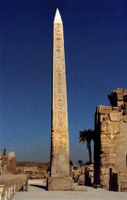Difference between revisions of "Obelisk"
(Created page with "File:lighterstill.jpgright|frame ==Origin== Middle French ''obelisque'', from Latin ''obeliscus'', from Greek ''obeliskos'', from diminutiv...") |
m (Text replacement - "http://" to "https://") |
||
| (2 intermediate revisions by 2 users not shown) | |||
| Line 3: | Line 3: | ||
==Origin== | ==Origin== | ||
Middle French ''obelisque'', from [[Latin]] ''obeliscus'', from [[Greek]] ''obeliskos'', from diminutive of ''obelos'' | Middle French ''obelisque'', from [[Latin]] ''obeliscus'', from [[Greek]] ''obeliskos'', from diminutive of ''obelos'' | ||
| − | *[ | + | *[https://en.wikipedia.org/wiki/16th_century 1561] |
==Definition== | ==Definition== | ||
*1: an upright 4-sided usually monolithic [[pillar]] that [[gradually]] tapers as it rises and terminates in a [[pyramid]] | *1: an upright 4-sided usually monolithic [[pillar]] that [[gradually]] tapers as it rises and terminates in a [[pyramid]] | ||
| Line 12: | Line 12: | ||
The term ''stele'' is generally used for other monumental, upright, [[inscribed]] and sculpted stones.[https://en.wikipedia.org/wiki/Obelisk] | The term ''stele'' is generally used for other monumental, upright, [[inscribed]] and sculpted stones.[https://en.wikipedia.org/wiki/Obelisk] | ||
| + | ==See also== | ||
| + | *'''''[https://nordan.daynal.org/wiki/index.php?title=2017-07-04-Setting_the_Record_Straight#Oregon_Group_2 Crystal City Obelisks]''''' | ||
[[Category: Architecture]] | [[Category: Architecture]] | ||
Latest revision as of 01:32, 13 December 2020
Origin
Middle French obelisque, from Latin obeliscus, from Greek obeliskos, from diminutive of obelos
Definition
- 1: an upright 4-sided usually monolithic pillar that gradually tapers as it rises and terminates in a pyramid
Description
An obelisk from Ancient Greek: ὀβελίσκος obeliskos; diminutive of ὀβελός obelos, "spit, nail, pointed pillar") is a tall, four-sided, narrow tapering monument which ends in a pyramid-like shape or pyramidion at the top. These were originally called "tekhenu" by their builders, the Ancient Egyptians. The Greeks who saw them used the Greek 'obeliskos' to describe them, and this word passed into Latin and ultimately English. Ancient obelisks are monolithic; that is, they consist of a single stone. Apart from its shape, this is the major identifying characteristic of an obelisk, as it necessitates the technological ingenuity required to elevate into vertical position a massive rock weighing hundreds of tonnes.
Though this technological capacity exists today, most modern obelisks are made of several stones; some, like the Washington Monument, are buildings.
The term stele is generally used for other monumental, upright, inscribed and sculpted stones.[1]
